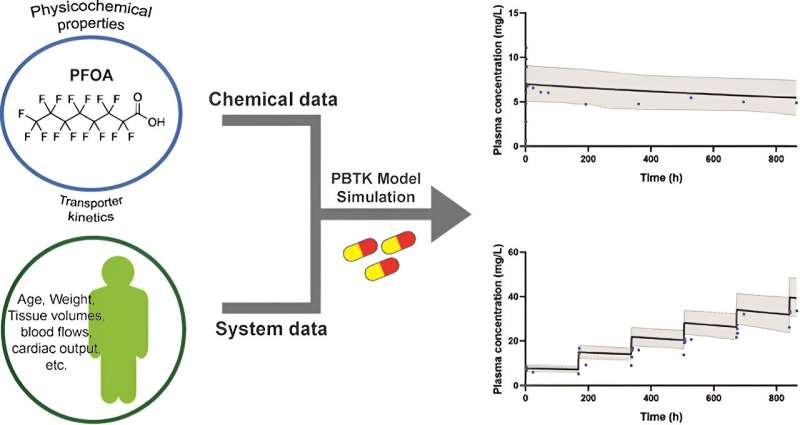This article has been reviewed according to Science X's editorial process and policies. Editors have highlighted the following attributes while ensuring the content's credibility:
fact-checked
peer-reviewed publication
trusted source
proofread
New understanding of perfluorooctanoic acid could pave the way towards safer products and better human health

A team of A*STAR scientists has made a significant breakthrough in understanding how perfluorooctanoic acid (PFOA) is processed by the human body.
Led by Dr. James Chan, Junior Principal Investigator at A*STAR's Singapore Institute of Food and Biotechnology Innovation (SIFBI) and the A*STAR Skin Research Labs (A*SRL), the research team used a virtual model that replicates the biological traits of the human body's chemical processing mechanisms to investigate how PFOA is processed.
PFOA is an environmental contaminant prevalent in food, food packaging, and consumer products such as non-stick cookware, rugs and cosmetics. It is widely used in various industrial and consumer applications due to its oil-, water-, and heat-resistant properties, and humans are primarily exposed to it through oral ingestion.
It is highly persistent in humans, with a lengthy half-life (amount of time it takes for half of a quantity of a substance to decay or degrade) of up to four years. This can potentially lead to health concerns including liver and kidney cancer, thyroid issues, developmental effects on the immune and reproductive systems, and fetal development. In Singapore, PFOA appears in 99% of tested blood samples from local cohorts, influencing fertility in women.
Despite associations with harmful effects, research on the critical levels of PFOA exposure, and how the human body eliminates it, is limited. This research sheds light on the biology of PFOA, and the mechanisms for its high resistance to biological degradation in humans, which could potentially help the industry design safer replacement chemicals for industrial and consumer products. Regulatory bodies could also employ the findings to measure the impact of PFOA and explore safety limits in products.
The findings highlight that PFOA binds strongly to blood proteins which act as a magnet, limiting its ability to be filtered by the kidney and thus reducing the speed of its elimination. Additionally, as PFOA resembles the fatty acids that our body needs, the kidney reabsorbs PFOA from the urine, mistaking it for an essential nutrient. Finally, PFOA uses the same pathway as essential fatty acids to enter our tissues, allowing it to be widely distributed within all body organs, increasing the potential for harm. By understanding how PFOA persists in the body, these insights could contribute to the development of safer next-generation chemicals for use in various products.
The model is currently being used to investigate the sources of PFOA exposure within the Singapore population. There are plans to expand the use of the model to investigate other Per- and Polyfluoroalkyl Substances (PFAS), of which PFOA is only one of over 14,000 such chemicals, to help regulatory bodies measure the amount of PFAS in consumer products. The research team has also developed assays that the industry could adopt to test whether their replacement chemicals contain the same properties as PFOA (e.g., a lengthy half-life).
"The data surrounding PFOA is mixed, with some studies suggesting PFOA resides for several months, and others, for years. Our study is the first to provide a rational explanation to these reports by using data of human origin, and not animal models, to reveal the true persistence of PFOA in humans."
"More importantly, it sets forth a general approach that others can use to study PFAS which we know very little about. There are many more of such chemicals that we are exposed to with yet unknown consequences. We hope to work with the broader scientific community to understand their potential for harm and contribute towards better population health," said Dr. James Chan, senior author of the study.
The paper, "Mechanistic Middle-Out Physiologically Based Toxicokinetic Modeling of Transporter-Dependent Disposition of Perfluorooctanoic Acid in Humans," is published in Environmental Science & Technology.
More information: Jieying Lin et al, Mechanistic Middle-Out Physiologically Based Toxicokinetic Modeling of Transporter-Dependent Disposition of Perfluorooctanoic Acid in Humans, Environmental Science & Technology (2023). DOI: 10.1021/acs.est.2c05642
Journal information: Environmental Science & Technology





















